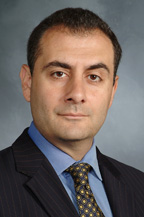Rise of Minimally Invasive Endoscopic Surgery in Gastroenterology: Focus on Achalasia

Michel Kahaleh, M.D.
Since Dr. Michel Kahaleh joined the department, there has been a 175% increase in advanced endoscopic interventional procedures in gastroenterology as well as the launch of the first pancreatic program at NYP/Weill Cornell. Under his direction, there has also been a rise in the number of minimally invasive endoscopic techniques that are highly effective, safe, and spare patients from major surgeries. For example, Dr. Kahaleh and team have been utilizing endoscopic necrosectomy for pancreatic necrosis, which involves a larger stent to treat an infected or abscessed pancreas and is reducing mortality rates compared to surgery; EDGE, a procedure that allows ERCP to be performed for the removal of bile duct stones in patients who have had a gastric bypass operation, which will be presented as an abstract at the Digestive Disease Week 2014 in Chicago; and endoscopic submucosal dissection for early cancer (or precancer) of the stomach, rectum or esophagus.
Another minimally invasive procedure that Dr. Kahaleh has been advancing is Peroral Endoscopic Myotomy (POEM) for the treatment of esophageal achalasia. He has been utilizing the procedure not only here at Weill Cornell and Columbia (New York Presbyterian) but also around the world, including Columbia (Bogata), and Venezuela. Achalasia in its primary form has no known underlying cause; a small proportion of cases occur due to esophageal cancer, or as a result of Chagas Disease. “Achalasia is very prevalent in Latin America,” explains Dr. Kahaleh, “due to Chagas disease, which is caused by a parasite.”
Achalasia involves incomplete lower esophageal sphincter relaxation (LES) and poor peristaltism of the esophagus. The smooth muscle layer of the esophagus and the LES are unable to move food along its path and down the esophagus. Achalasia can cause extreme discomfort for the patient with symptoms of dysphagia (difficulty in swallowing), regurgitation of food, and chest pain. The chest pain in this situation is not the type related to having a heart attack, but nonetheless painful. There have been various treatments available for achalasia, such as oral medications, dilation (stretching of the esophageal sphincter), and Botox injections, although none of these fully cure the condition and typically provide only temporary results.
POEM is a highly effective treatment that removes (endoscopically) the outside muscle layers of the esophagus causing the pressure that is squeezing the esophagus. “By removing a certain portion of the muscle, equilibrium is restored to the esophagus and permits patients to eat better. This procedure requires no major incisions and the patient may return home typically within 2-3 days.”
To date, Dr. Kahaleh has utilized POEM to treat 26 cases of esophageal achalasia and this has launched an international registry that will undoubtedly help to advance clinical research around the world.
Click for Dr. Kahaleh's Physician Page
For information on Dr. Kahaleh's work on pancreatic necrosectomy, please click for his recent paper in the Journal of Clinical Gastroenterology.